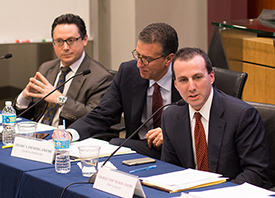Attorney Tom Kline and a panel of attorneys described the legal strategy that produced the $265 million Amtrak derailment settlement, the largest monetary agreement following a railroad disaster in U.S. history, at a CLE on Nov. 22.
The settlement followed a complex negotiation after the 2015 derailment of an Amtrak Northeast Corridor train, in which eight of the 238 passengers died and more than 50 others sustained catastrophic injuries.
“There is a lack of safety on our rails today, and the victims paid the price for it,” said Kline, a founding partner of Kline & Specter who was appointed to the Plaintiffs Management Committee that negotiated the historic settlement program.
The settlement made tremendous sense, Kline explained, since there was no doubt as to Amtrak’s liability and federal law caps damages in accidents involving single passenger trains.
The Plaintiffs Management Committee, which also comprised attorneys from firms including Eisenberg Rothweiler and Saltz Mongeluzzi, streamlined the process of seeking justice for the victims, who were represented by 55 lawyers who had filed 64 actions in six federal districts before 19 judges.
 “It does make a lot of sense to coordinate as best as you can,” Kline & Specter partner Charles Becker said. “Our cases have the same defendant, the same theory of liability.”
“It does make a lot of sense to coordinate as best as you can,” Kline & Specter partner Charles Becker said. “Our cases have the same defendant, the same theory of liability.”
While many defendants oppose multidistrict litigation, Becker said, Amtrak was very willing to seek resolution this way.
“The MDL process tries to find a happy medium, creating a structure that works for the courts and the parties,” Becker said, noting that Amtrak very quickly admitted liability in the accident.
Kline noted, however, that Amtrak’s admission of liability was limited and that the $200 million cap that existed under law was unlikely to cover the victims’ claims.
Fortunately, Kline said, a long-languishing omnibus transportation bill came up in Congress and “became an opportunity for able advocacy,” and the cap on damages was raised to $295 million.
Kline added that Becker provided “the legal backbone” for passing the bill over the objections of lobbyists and that the higher cap was made retroactive to the derailment, which had occurred months earlier.
Eisenberg Rothweiler attorney Todd Schoenhaus said meticulous preliminary work done by Kline & Specter and Saltz Mongeluzzi eased the process.
“The original complaint set the table,” Schoenhaus said. “The original complaint created a narrative that indicted Amtrak and indicted the acts and omissions of the conductor.”
Still, Kline said, the prospect of getting dozens of individual plaintiff’s attorneys to negotiate with the Plaintiffs Management Committee and encourage their clients to participate in a settlement program poses potential challenges.
Eisenberg Rothweiler attorney Fred Eisenberg said Judge Legrome Davis of the U.S. District Court for the Eastern District of Pennsylvania eased that process by appointing attorneys from different states and diverse firms to serve on the Plaintiffs Management Committee.
“It led to a level playing field for the lawyers and their clients,” Eisenberg said.
After holding numerous meetings with Amtrak and surveying plaintiffs through questionnaires, the committee arrived at the settlement value of $265 million, Kline said.
Each plaintiff’s share of the settlement will be determined by one of two masters Davis has appointed but whose identities won’t be known until December, Kline added.
The goal is to resolve all of the claims by April 28, 2017, Kline said, voicing confidence that the deadline will be met.
The smooth resolution of the complex negotiation could be instructive to lawyers elsewhere, Kline said.
“We hope it will be a model in MDL litigation,” he said.